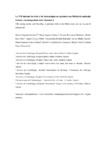Mostrar o rexistro simple do ítem
La INR durante los ictus y las hemorragias en pacientes con fibrilación auricular tratados con antagonistas de la vitamina K
| dc.contributor.author | Anguita-Sánchez, Manuel | |
| dc.contributor.author | Anguita Gámez, María | |
| dc.contributor.author | Bertomeu, Vicente | |
| dc.contributor.author | Ruiz Ortiz, Martín | |
| dc.contributor.author | Cequier, Ángel | |
| dc.contributor.author | Roldán, Inmaculada | |
| dc.contributor.author | Muñiz, Javier | |
| dc.contributor.author | Esteve-Pastor, María Asunción | |
| dc.contributor.author | Vivas Balcones, David | |
| dc.contributor.author | Marín, Francisco | |
| dc.contributor.author | Pérez-Villascastín, Julián | |
| dc.date.accessioned | 2022-06-22T12:15:32Z | |
| dc.date.available | 2022-06-22T12:15:32Z | |
| dc.date.issued | 2020-07 | |
| dc.identifier.citation | Anguita Sánchez M, Anguita Gámez M, Bertomeu Martínez V, Ruiz Ortiz M, Cequier Fillat Á, Roldán Rabadán I, et al. La INR durante los ictus y las hemorragias en pacientes con fibrilación auricular tratados con antagonistas de la vitamina K. REC CardioClinics. 2020;55(3):131-138 | es_ES |
| dc.identifier.issn | 2605-1575 | |
| dc.identifier.uri | http://hdl.handle.net/2183/30972 | |
| dc.description.abstract | [Resumen] Introducción y objetivos. La fibrilación auricular tiene un mal pronóstico asociado fundamentalmente al desarrollo de ictus. A pesar del uso de anticoagulantes, algunos pacientes pueden sufrir ictus y también hemorragias graves. El tratamiento con antagonistas de la vitamina K (AVK) se controla mediante la razón internacional normalizada (INR). Nuestro objetivo fue estudiar la incidencia de ictus y hemorragias mayores, e investigar los valores de la INR y el tiempo en rango terapéutico en los 6 meses previos durante dichos episodios en pacientes con fibrilación auricular tratados con AVK. Métodos. Se incluyeron 1.483 pacientes con fibrilación auricular tratados con AVK durante al menos los 6 meses previos, incluidos consecutivamente desde junio de 2013 hasta octubre de 2014, con una mediana de seguimiento de 32,4 meses. Se identificaron aquellos pacientes que ingresaron por ictus o hemorragia mayor y se determinó la INR en cada episodio. Resultados. Se registraron 40 ictus (1,07/100 pacientes/año) y 120 hemorragias mayores (3,28/100 pacientes/año). La INR durante los ictus fue 2,33 ± 0,59, y durante las hemorragias 3,17 ± 1,48. El 57,5% de los pacientes tenían una INR de 2-3 durante los ictus y el 48,3% durante las hemorragias. Los pacientes que sufrieron un ictus con una INR fuera de rango durante el episodio presentaron un tiempo en rango terapéutico más bajo que aquellos con la INR en rango (49,2 ± 20,8% frente a 68,8 ± 19,4%; p = 0,043). Conclusiones. La mitad de los ictus y hemorragias mayores se producen con valores de la INR «adecuados» (2 a 3). Cambios en la estrategia de anticoagulación pueden ser necesarios para disminuir esta elevada tasa de eventos. | es_ES |
| dc.description.abstract | [Abstract] Introduction and objectives. Atrial fibrillation has a poor prognosis, mainly due to the occurrence of cardioembolic stroke. Despite the use of anticoagulants some patients can develop stroke as well as severe bleeding. Treatment with vitamin K antagonists is usually controlled by means of the international normalized ratio (INR). The aim of this study was to investigate the incidence of stroke and major bleedings, as well the values of INR and the time in therapeutic range within the previous 6 months during these events. Methods. The study included 1483 patients with atrial fibrillation treated with vitamin K antagonists for at least 6 months prior to inclusion, consecutively recruited from June 2013 to October 2014, with a median follow-up of 32.4 months. Those patients admitted due to an episode of stroke or severe bleeding were identified, and an analysis was performed on the INR values obtained for each episode. Results. There was a total of 40 strokes (1.07/100 patients/year) and 120 severe bleedings (3.28/100 patients/year) during the study period. The mean INR value during stroke episodes was 2.33 ± 0.59, and during severe bleeding 3.17 ± 1.48, with 57.5% of patients having had an INR of 2-3 during strokes, and 48.3% during bleedings. Patients with an INR out of range during the stroke had a time in therapeutic range lower than those with an INR between 2 and 3 during the event (49.2 ± 20.8% vs. 68.8 ± 19.4%; P = .043). Conclusions. More than 50% of strokes and almost 50% of severe bleedings occur with ‘adequate’ (2 to 3) INR values. Changes in the anticoagulation strategy seem to be necessary to decrease this high rate of severe events. | es_ES |
| dc.language.iso | spa | es_ES |
| dc.publisher | Elsevier | es_ES |
| dc.relation.uri | https://doi.org/10.1016/j.rccl.2019.12.001 | es_ES |
| dc.rights | Creative Commons Attribution-NonCommercial-NoDerivs 4.0 International License (CC-BY-NC-ND 4.0) | es_ES |
| dc.rights.uri | http://creativecommons.org/licenses/by-nc-nd/4.0/ | * |
| dc.subject | Fibrilación auricular no valvular | es_ES |
| dc.subject | Ictus | es_ES |
| dc.subject | Hemorragias graves | es_ES |
| dc.subject | Antagonistas de la vitamina K | es_ES |
| dc.subject | INR | es_ES |
| dc.subject | Tiempo en rango terapéutico | es_ES |
| dc.subject | Non-valvular atrial fibrillation | es_ES |
| dc.subject | Stroke | es_ES |
| dc.subject | Severe bleeding | es_ES |
| dc.subject | Vitamin K antagonists | es_ES |
| dc.subject | Time in therapeutic range | es_ES |
| dc.title | La INR durante los ictus y las hemorragias en pacientes con fibrilación auricular tratados con antagonistas de la vitamina K | es_ES |
| dc.title.alternative | INR during stroke and bleeding in patients with atrial fibrillation and on vitamin K antagonists | es_ES |
| dc.type | info:eu-repo/semantics/article | es_ES |
| dc.rights.access | info:eu-repo/semantics/openAccess | es_ES |
| UDC.journalTitle | REC: CardioClinics | es_ES |
| UDC.volume | 55 | es_ES |
| UDC.issue | 3 | es_ES |
| UDC.startPage | 131 | es_ES |
| UDC.endPage | 138 | es_ES |






